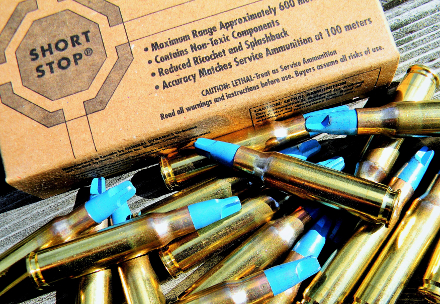
Training with the 5.56 and 7.62 mm rounds can be an issue with respective possible maximum ranges of 2 to 3 miles. This creates a huge danger zone and requires a considerable area of land on which to safely conduct training. Up close, ricochet and splash back can also be an issue. Practicing with conventional ammunition in urban areas or on indoor ranges can be problematic as well. The use of blanks does not allow realistic training, for the absence of recoil and the lack of a projectile does not allow confirmation of accurate hits on paper, or allow for engagement of reactive steel targets. Is there safer ammunition for this purpose?
General Dynamics, Ordinance and Tactical Systems have addressed these issues with the development of their Short Stop® 5.56mm and 7.62mm ball and tracer short-range ammunition (www.always-on-target.com). The author was able test some of the ammunition while at Media Day, before SHOT Show in early 2014. Intrigued by the concept, ammunition in both calibers was requested for more thorough testing.
Chapter 1: General Dynamics
In their mission statement is the desire: To be recognized as the world leader for short-range, non-toxic training cartridges, and to provide the best training systems possible so that officers, military forces and approved range members can engage in experience building, and ultimately lifesaving exercises. For those purposes, three types of cartridges have been developed.
- The CQT® cartridge training system which is comprised of a CQT® cartridge and weapon conversion kit for target shooting, indoors or out, for basic firearms training or advanced tactical shooting exercises.
- The GREENSHEILD® is a truly frangible, lead-free, full-energy training ammunition, designed to reduce health and safety hazards by eliminating exposure to lead and other heavy metals.
- The Short Stop® Short-Range Training Ammunitions (SRTA) are designed for use on ranges where ricochet and stray bullets travelling beyond standard target distances pose a problem. The last item is the topic of this review.
...
Chapter 2: Unique Projectiles
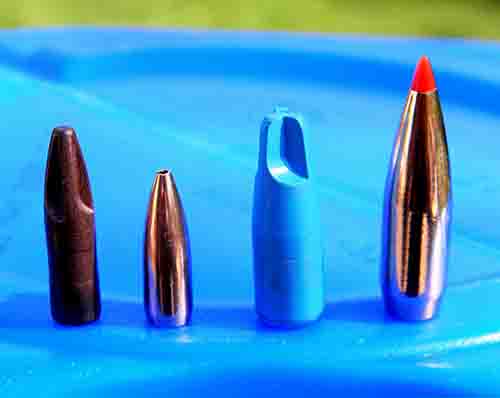
All Short Stop® cartridges- available in 5.56 mm, 7.62 mm and .50 caliber BMG- feature projectiles produced from a lighter than normal weight, frangible copper-filled polymer, which lowers the danger of ricochet and splashback, while eliminating environmental contamination. How frangible are the projectiles, and what is their ricochet potential?
When fired at a steel plate, angled only 5-degrees (five) from the bore, the bullet will fully fragment. How low is the danger of splashback? Fired at steel plate fully perpendicular- 90 degrees- to the bore, at a distance of only one-meter, there is no splashback to the shooter. Comprised of a compressed copper-filled polymer, they are lead-free, and therefore, friendly to the environment.
They match the accuracy of conventional ammunition out to 100 meters with a point of impact at or comparable to conventional ammunition. So far, they may seem like other frangible rounds. But the primary design goal is that they have limited possible range to allow safe use on handgun ranges without greatly reducing powder charges to keep blast at realistic training levels, or turning to building mild “squib” loads that would not function semi- or full automatic weapons. Brilliant simplicity of projectile design resulted in dramatically reducing the maximum range to 600 meters for the two smaller calibers, and only 800 meters for the huge .50 BMG. How was this done?
Chapter 3: Reversing Stability
By purposefully causing the projectile to become unstable, this first leads to keyholing and then tumbling to greatly increase the velocity loss over distance of the much lighter and dramatically less dense polymer projectile. This is accomplished by molding flutes into the nose to counteract normal bullet rotational spin, which is required to stabilize a projectile. The flutes- four on the 5.56 mm and .50 calibers, three on the 7.62 mm- begin by being straight at the nose, progressing rearward, but end in a curve on the forward face, which counteracts the clockwise rotation of right-hand...
twist rates.
This airflow causes the bullets to want to spin counter-clockwise, undoing the clockwise spin imparted by the rifling.
Using the 7.62 as an example, the Short Stop® projectile leaves the muzzle of the Ruger’s barrel with a right hand, clockwise spin of one turn in ten inches. As the considerable pressure of the air on the nose of the bullet races down the flutes, then hits the curved face, the air pressure will cause the bullet to want to spin left hand, counter-clockwise, and counteract the spin imparted by the rifling, causing the rifling imparted bullet spin rate to gradually slow down. At some distance downrange, the actual spin rate of the bullet will slow down to 1 turn in 10-1/2 inches, then one in 11 inches, and so on, farther and farther down range. This will result in the bullet departing slightly from point of aim.
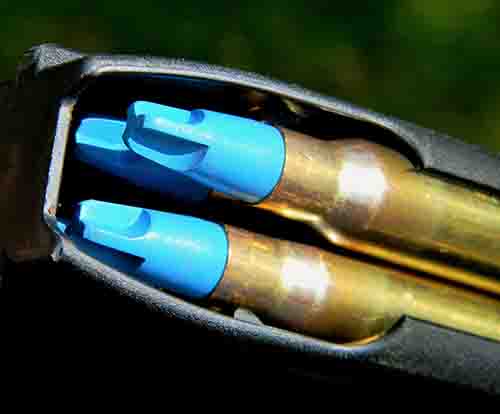
The resulting instability will first appear on paper targets as slightly elongated holes, or keyholing. Farther out, the bullets will yaw even more. This can clearly be seen on the targets shot at 50 and 100 meters with the 7.62 projectile. See how at 25 meters the 7.62 projectiles still produce nice round holes.
If we could ignore the fact for a moment, that bullets even require spinning to remain stable, the ending curves in the Short Stop® projectiles produce tremendous counter-clockwise air pressure. This would eventually result in the bullet finally reaching a spin rate of zero at some distance from the muzzle. Then… causing the bullet to begin to spin counter-clockwise (opposite of the initial spin cause by the rifling), slowly at first, but then increasing in quickness over time and distance. Of course, this is not possible, as well before that, the bullet reducing spin rate would result in instability and tumbling.
However, for illustration only, think of a powerful fan on smooth bearings, blowing into a very hard wind. Turn the fan off, and eventually the blades will come to a stop, but then the strong wind will begin to cause the blades to spin in the opposite direction, from when the fan was initially...
blowing hard into the wind. Same principle, beautifully engineered into the flutes and curves in all Short Stop® projectiles.
Chapter 4: Twist Rates Must Be Correct

I had access to two rifles for my tests: a Ruger SR-762 in .308/7.62 mm with a 1-10” twist rate and a DPMS LBR (Light Battle Rifle) in .223/5.56 mm with a 1-9” twist rate. For normal heavier weight military bullets, the 5.56 mm requires a 1-7” right hand twist rate to stabilize the 62 grain projectile. Slower than that, such as a 1-8 or 1-9” twist rate (or even slower), and the bullet will begin to wobble, print keyholes on target at closer ranges, and begin to actually tumble farther out.
Note the target shot by the 5.56 mm ammo at only 25 meters with the 35 grain copper/polymer Short Stop® projectile. Even at that short distance, the bullets were passing through fully sideways! Compare that to the Ruger SR-7.62 mm rifle, having the correct 1-10” twist rate, at the same distance. Nice round bullet holes showing the 65 grain copper/polymer bullets were still fully stable at that distance.
Chapter 5: Range Day- 5.56
Due to the uniqueness of Short Stop® cartridges, I felt it necessary to first explain how they work before going into specifics about the ammo and technical performance. As copper/ polymer projectiles, they come in quite a bit lighter than normal weight. As stated earlier, the 5.56 weigh ~35 grains are a quite long 0.901” and are of a copper/bronze color. Current production ammo in this caliber will be tip painted a medium blue. The powder charge averaged 26.5 grains of a slightly flattened ball powder. From my only 16” test barrel, they produced a very fast 3,300 fps, 3 meters from the muzzle. This ammunition fired and cycled my DPMS normally, as a gas operated AR-15 should. Note the factory states the speed as 2,625 fps at 24 meters, the distance at which the military chronographs munitions.
The loss of around 675 fps in only 21 meters seems rather high to me. When I contacted the manufacturer, they stated they only chronograph at the desired military distance. While I...
was hopeful my 1-9” twist rate would stabilize the long bullet, it did not, as evidenced by the targets shot at only 25 meters. It is amazing to me that a bullet could be going sideways that quickly, and every one struck the paper perfectly sideways at that distance when over 40 rounds were test fired.
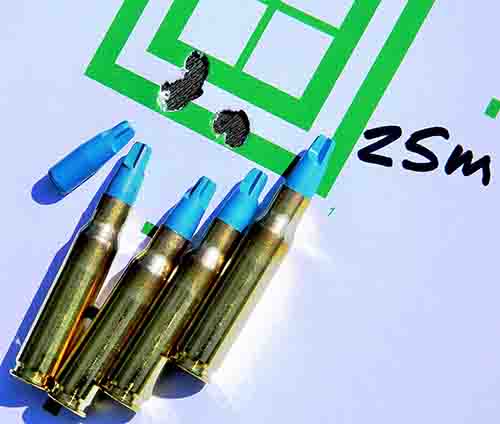
As a test, I progressively cut the distance in half each time: first at 12.5 meters, then down to 6, closer again to 3, and finally shooting at only 1.5 meters (about 5 feet). Amazingly, at only 5 feet, the bullets were already beginning to keyhole… and all were fully sideways at 3 meters (10 feet)! At 50 meters, three shots were fully sideways and grouping into 3”. No testing was performed beyond that distance with this ammo. This rifle has shot conventional ammunition at well under one-inch at 100 meters.
Chapter 6: Ruger SR-762
For the 7.62 Short Stop® a new Ruger SR-762 with its 16” barrel was used. The velocity at 3 meters was 2,825 fps for the 65 grain medium blue projectile when propelled by an average of 46 grains of a similar flattened ball powder. This is not a blue coating, but its color throughout. Note that factory stated velocity with this round at 24 meters is 800 m/s (2,625 fps). Scraping the bullet with a knife reveals copper in a small powder form, but the bullet as a whole does not reveal any exposed copper particles. At 25 meters, it would regularly place three rounds into 0.40” with the other two very close by. Five shot averages ran around 0.79” at that distance with point of impact being 1.2” below point of aim using a scope. All holes in the target were perfectly round, demonstrating stability at that point.
Moving back to 50 meters, groups ran around 2” with the holes in the paper showing signs of keyholing just beginning- they formed ovals running from 3/8 ~ 1/2” - sometimes a flute or two producing clean narrow cuts in the paper opposite the base end oval. The bullets were striking to point of aim at this distance when using a Leupold 3-9 European scope with a 30 mm tube. The same target shot at 50 meters was then taken back to 100. Point of impact now averaged 1.6” above point of...
aim and to the right 1.6” also.
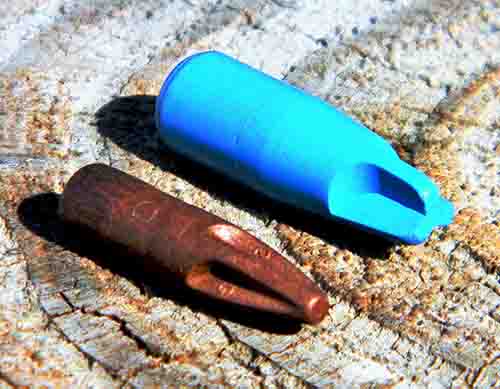
Full power handloads with 168 grain Nosler Competition bullets were striking dead center, left to right, and 1.2” high, with 1.2” group averages. The Short Stop ammo averaged around 2-3/4” at 100 meters- good enough to hit a clay bird with every shot. The holes in the paper produced at the longer range were not quite as clean cut as the ones at 50, perhaps due to going slower, or possibly because of a lighter target backer was in use at 100, but they did exhibit the same degree of keyholing as those at only 50 meters. None out of over 40 rounds fired at 100 meters were anywhere close to showing a full sideways projectile strike.
Hitting steel plates at that distance resulted in a solid “clang” with each shot. Based on that, I then set up some steel chicken silhouettes on a rail, which resulted in solid hits and convincingly knocking every one down. The 7.62 rounds were developed to function in the M240B machine gun and offer cycling in the full auto mode. They did not cycle the Ruger though, even when the four position gas piston regulator was set to allow the most possible gas to work against the piston for cycling. Not a real issue- just noted to inform you that perhaps some piston guns may not cycle the ammunition with its light weight projectile.
In an unfired state, is the ammo delicate, and could the projectiles break off if given rough handling?
I doubt that, as when I placed the 5.56 projectiles in a pair of pliers, it took a considerable amount of force for the end of the jaws to squeeze through the bullet. Taking that piece, setting it on concrete and smacking it quite hard with a two-pound hammer resulted in the section only breaking up into two or three smaller sections. The polymer compound obviously gives great ductability to the projectile- at pedestrian impacts; it’s not at all delicate or frangible.
Having a considerably greater cross section, it took over double the force with the pliers to pinch the 7.62 in half across the diameter. And again, one hard whack with the hammer only served to squash the blue fragment, with cracking to...
a small degree. So with general or even rough handling, there appears to be no fear of causing physical damage to the copper/polymer projectiles.
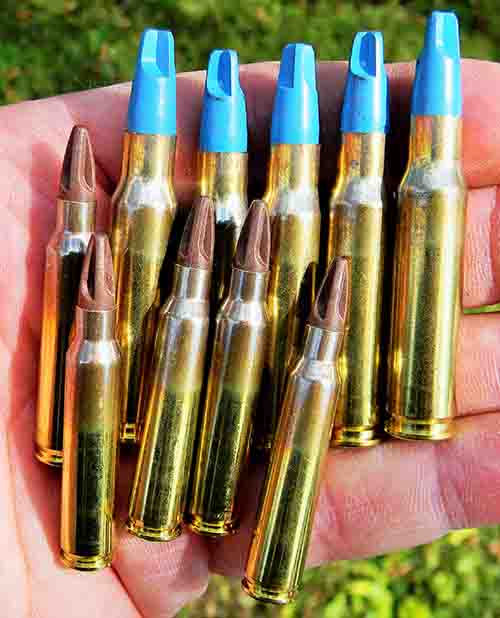
Chapter 7: Summary
Additionally, the unique design of the Short Stop® bullet allows it to match the accuracy of conventional ammunition at 100 meters, while dramatically reducing the maximum range to 600 meters due to the induced instability of the round over distance. Specific features and advantages of Short Stop ammunition include:
- No weapon modifications are required
- Non-toxic projectiles
- Greatly reduced danger zone, greatly improving training flexibility
- Excellent accuracy and ballistic match to conventional ammunition at 100 meters
- Similar recoil, noise level and function as conventional ammo
- Frangible projectiles reduce damage to range infrastructure and targets
Additionally, its greatest advantage, I believe, is a huge decrease in the Surface Danger Zone (SDZ), being only approximately 1% of conventional munitions.
The SDZ is an area associated with a training range which is designed to protect people during weapons training. It may include land, water, and airspace. When a range is in active use, the SDZ is an exclusion area that is strictly controlled, as it could contain projectiles or fragments from firing weapons.
Presently only available for sale to military and law enforcement, there are plans to make it available to the general public, at least in North America, during 2015. It is amazing to me that while frangible ammunition has been produced for quite a while, the researchers at General Dynamics thought to purposefully induce instability into the projectile by including fluting to counteract the spin normally induced by rifling, resulting in instability and tumbling to drastically reduce the maximum possible range.